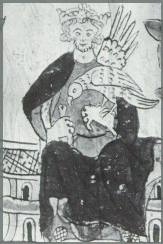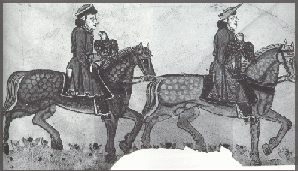
Pentecost: This was the religious festival celebrated on the seventh Sunday after Easter (also called Whitsun). The festival is to remember the day when the Holy Spirit came down from Heaven to Jesus' disciples and gave them 'the gift of tongues' so that they were able to go abroad and spread the word of Jesus in many languages.
bedchamber: A 'chamber' meant a room in the Middle Ages. So the bedchamber is the bedroom.
challenged: The Knight of the Spring is complaining that Calogrenant has not done things properly. If a knight was angry about something and wanted to fight he was supposed to go to him and challenge him to a combat, making clear his reasons for doing so and arranging a time and place for the fight. Throwing down his armoured glove (called a gauntlet) was one way a knight could give a challenge in the Middle Ages.
falcon: A hawk, a bird of prey trained to hunt smaller birds. This sport was very popular throughout the Middle Ages. There were strict laws about what kind of hawk you could keep, depending on your position in society.

King Stephen, who reigned from 1135 to 1154, with his pet falcon

Hawking on horseback
squire: Squires were young men from noble families training to be knights. They learnt about knighthood by living with a knight and looking after his armour and horses.
prowess: A knight's prowess was his courage and daring, and his strength and skill at fighting.
Norman ancestors: The Kings of England were descended from William the Conqueror, Duke of Normandy, who became ruler of England when he defeated the Anglo-Saxon King Harold in 1066. In the 12th Cenury, for example, Henry II was William's grandson, and so he was Duke of Nomandy as well as King of England. His father was the Count of Anjou and his wife was Eleanor of Aquitaine, so Henry ruled over these lands as well - but as the 'vassal' of the King of France.
chain mail: Armour made from connected metal rings.
hauberks: Coats made of mail (metal rings linked tightly together) to protect the body.
chivalry: A set of ideas about how a good knight should behave. These included treating women with respect, defending the weak and the poor and fighting fairly.
bier: A flat wooden tray for carrying the dead.
portcullis: A metal grille that could be let down to block the gateway of a castle.
censers: A metal pot on a chain with incense burning in it. They are still used in some churches today. The priest swings the censer and the sweet-smelling smoke is spread about the church.
Feast of Saint John: Saint John's Day is the 24th June, and celebrates the birth of John the Baptist.
Steward: A steward was in charge of running a lord or lady's castle and estates. He could be an important person, carrying out his lord/lady's orders, reporting on the affairs of the estate and giving advice.
Pesme Aventure: The Castle of Pesme Aventure means the Castle of Evil Fortune.
relic: Relics were believed to be parts of the body of a saint, or of Jesus himself, or objects connected with his life (the cross, for example, or the crown of thorns). Many churches and monasteries had a holy shrine where relics were kept, and people would come on pilgrimage to pray before them, or perhaps even to touch them. This was believed to cure diseases and perform other miracles.
Since relics were thought to be so holy, it was quite common for people to swear oaths while touching them, to make the oath particularly binding. Witnesses in court today still put one hand on the Bible as they promise to tell 'the truth, the whole truth and nothing but the truth'.
Knights often kept a relic - such as a tiny bottle of Christ's blood - inside the hilt of their sword. They hoped this would make them a good knight and bring God's help in battle.
hold his stirrup: Holding someone's stirrup to help them dismount from their horse was a polite way to greet a guest and show that he was welcome. For the lord or lady of a castle to do it (rather than a servant) was especially courteous and meant that the guest was an important one.
Bringing someone a last drink (called a 'stirrup cup') when they were already on their horse but before they rode away was also a mark of courtesy.
swore oaths: Nowadays, two warring sides may sign a Peace Treaty to end their conflict. In the Middle Ages, peace could be agreed by making solemn promises (swearing oaths) in the presence of witnesses. Count Alier does not only swear that he will not attack the Lady's town and will repair the damage he has done. He also gives 'pledges' - these are meant to make sure that he will keep these promises. For example, he might leave some of his men as hostages, or offer land or money which will belong to the Lady if he breaks his word.
tribute: This was payment made to a more powerful King or Emperor by a less powerful one. When a King was defeated, and his country conquered, for example, he might have to agree to pay 'tribute' every year to the ruler who had beaten him. This payment was often money, but it could be people too, as hostages or slaves, or to use as soldiers.
pillories: A pillory was a wooden frame on a pillar, with holes for the head and arms. Someone who had committed a crime had to stand in the pillory in a public place for passers by to see and ridicule. So, like a cart, the pillory was a way of shaming wrong-doers in public.